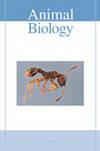膜翅目巨蜂属捕巢蜂及其亚属三种巢巢生物学研究产于北印度的巨型甲虫科
IF 0.9
4区 生物学
Q2 ZOOLOGY
引用次数: 0
摘要
对巨蜂陷阱巢类型适合度的研究表明,6种巨蜂(Megachile (Callomegachile)),即巨蜂(Megachile (Callomegachile) disjuncta,巨蜂(Pseudomegachile) lanata,巨蜂(Callomegachile) relata,巨蜂(Eutricharaea) studiosella和巨蜂(Megachile (Callomegachile) umbripennis在直径5-10毫米的隧道中筑巢,这些隧道以不同的形式提供(在巢桩和木原木上钻洞)。以及用竹竿和芦苇茎挖出的隧道)。对三种callomegachid蜜蜂,M. cephalalotes, M. disjuncta和M. umbripennis的筑巢生物学研究表明,它们在相似长度的隧道中筑巢(;直径(;)。三种植物的细胞壁和细胞壁有显著差异。M. cephalalotes雌虫用树脂建造它们的育雏室,留下一个空的空间。隔结巨柄雌虫在不留下任何基部空间的情况下,利用树脂和其他不同组合的材料建造了它们的育雏细胞。在M. umbripennis中,我们识别出两种不同类型的巢。一种与其他两种树脂蜂相似,通常有圆柱形或管状的巢室,另一种只有椭圆形的巢室,散布在筑巢隧道中。巢的结构细节表现出一些共同的特征,但也表现出种内和种间的差异。本研究提供了这些蜜蜂筑巢细节的新信息,包括它们的巢结构、幼虫发育和两代成虫的羽化模式,这对了解不同群体的巨型蜂的生态学有价值。本文章由计算机程序翻译,如有差异,请以英文原文为准。
Trap nesting bees of genus Megachile and nesting biology of three species of subgenus Callomegachile (Hymenoptera; Megachilidae) from North India
Studies conducted on the fitness of types of trap nests for Megachile bees showed that six species, viz. Megachile (Callomegachile) cephalotes, Megachile (Callomegachile) disjuncta, Megachile (Pseudomegachile) lanata, Megachile (Callomegachile) relata, Megachile (Eutricharaea) studiosella and Megachile (Callomegachile) umbripennis nested in tunnels (5-10 mm diameter), provided in different forms (drilled tunnels in bee nesting posts and wooden logs, and hollowed tunnels in bamboo sticks and reed stems). Nesting biology studies for three callomegachid bees, M. cephalotes, M. disjuncta and M. umbripennis, revealed that they nest in tunnels of similar length (; ) and diameter (; ). The cell walls and cell partitions were significantly different among the three species. The M. cephalotes females used resin to build their brood cells leaving an empty space. Megachile disjuncta females constructed their brood cells without leaving any basal space using resin as well as other materials in different combinations. In M. umbripennis, we recognized two distinct types of nests. One, similar to those of the two other resin bees usually having cylindrical or tubiform brood cells, and a second having only oval cells scattered all over in the nesting tunnel. The structural details of their nests exhibited several common features but also showed intraspecific and interspecific variations. This study provides new information on nesting details for these bees including their nest structure, brood development and adult emergence pattern for two different generations, which would be valuable in understanding the ecology of the diverse group of Megachile bees.
求助全文
通过发布文献求助,成功后即可免费获取论文全文。
去求助
来源期刊

Animal Biology
生物-动物学
CiteScore
2.10
自引率
0.00%
发文量
34
审稿时长
3 months
期刊介绍:
Animal Biology publishes high quality papers and focuses on integration of the various disciplines within the broad field of zoology. These disciplines include behaviour, developmental biology, ecology, endocrinology, evolutionary biology, genomics, morphology, neurobiology, physiology, systematics and theoretical biology. Purely descriptive papers will not be considered for publication.
Animal Biology is the official journal of the Royal Dutch Zoological Society since its foundation in 1872. The journal was initially called Archives Néerlandaises de Zoologie, which was changed in 1952 to Netherlands Journal of Zoology, the current name was established in 2003.
 求助内容:
求助内容: 应助结果提醒方式:
应助结果提醒方式:


